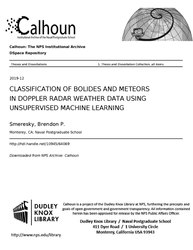File:CLASSIFICATION OF BOLIDES AND METEORS IN DOPPLER RADAR WEATHER DATA USING UNSUPERVISED MACHINE LEARNING (IA classificationof1094564069).pdf

Original file (1,275 × 1,650 pixels, file size: 6.54 MB, MIME type: application/pdf, 120 pages)
Captions
Captions
Summary[edit]
| CLASSIFICATION OF BOLIDES AND METEORS IN DOPPLER RADAR WEATHER DATA USING UNSUPERVISED MACHINE LEARNING
( |
||
|---|---|---|
| Author |
Smeresky, Brendon P. |
|
| Title |
CLASSIFICATION OF BOLIDES AND METEORS IN DOPPLER RADAR WEATHER DATA USING UNSUPERVISED MACHINE LEARNING |
|
| Publisher |
Monterey, CA; Naval Postgraduate School |
|
| Description |
This thesis presents a method for detecting outlier meteors and bolides within Doppler radar data using unsupervised machine learning. Principal Component Analysis (PCA), k-means Clustering, and t-Distributed Statistical Neighbor Embedding (t-SNE) algorithms are introduced as existing methods for outlier detection. A combined PCA and t-SNE method that uses a Nearest Neighbor Density Pruning method for dataset size reduction is also described. These methods are implemented to classify unlabeled radar data from four radar data sites from two bolide events: the KFWS radar for the Ash Creek bolide and the KDAX, KRGX, and KBBX radars for the Sutter’s Mill bolide. The combined PCA + t-SNE method gives an accuracy rate of 99.7% and can classify the data in less than 8 minutes for a 121,000 return sized dataset. However, the classifier’s recall and precision rates remained low due to difficulties in correctly classifying true positive bolides. Some ideas for improving algorithm accuracy, speed, and related follow-on applications are proposed. Overall, the algorithm presented in this research is a viable method to help NASA scientists with bolide detection and meteorite recovery. Subjects: asteroids; bolides; meteors; artificial intelligence; machine learning; unsupervised machine learning; principal component analysis; clustering; t-SNE; Doppler radar; nearest neighbors |
|
| Language | English | |
| Publication date | December 2019 | |
| Current location |
IA Collections: navalpostgraduateschoollibrary; fedlink |
|
| Accession number |
classificationof1094564069 |
|
| Source | ||
| Permission (Reusing this file) |
This publication is a work of the U.S. Government as defined in Title 17, United States Code, Section 101. Copyright protection is not available for this work in the United States. | |
Licensing[edit]
| Public domainPublic domainfalsefalse |
This work is in the public domain in the United States because it is a work prepared by an officer or employee of the United States Government as part of that person’s official duties under the terms of Title 17, Chapter 1, Section 105 of the US Code.
Note: This only applies to original works of the Federal Government and not to the work of any individual U.S. state, territory, commonwealth, county, municipality, or any other subdivision. This template also does not apply to postage stamp designs published by the United States Postal Service since 1978. (See § 313.6(C)(1) of Compendium of U.S. Copyright Office Practices). It also does not apply to certain US coins; see The US Mint Terms of Use.
|
 | |
| This file has been identified as being free of known restrictions under copyright law, including all related and neighboring rights. | ||
https://creativecommons.org/publicdomain/mark/1.0/PDMCreative Commons Public Domain Mark 1.0falsefalse
File history
Click on a date/time to view the file as it appeared at that time.
| Date/Time | Thumbnail | Dimensions | User | Comment | |
|---|---|---|---|---|---|
| current | 17:44, 15 July 2020 |  | 1,275 × 1,650, 120 pages (6.54 MB) | Fæ (talk | contribs) | FEDLINK - United States Federal Collection classificationof1094564069 (User talk:Fæ/IA books#Fork8) (batch 1993-2020 #11427) |
You cannot overwrite this file.
File usage on Commons
The following page uses this file:
Metadata
This file contains additional information such as Exif metadata which may have been added by the digital camera, scanner, or software program used to create or digitize it. If the file has been modified from its original state, some details such as the timestamp may not fully reflect those of the original file. The timestamp is only as accurate as the clock in the camera, and it may be completely wrong.
| Short title | CLASSIFICATION OF BOLIDES AND METEORS IN DOPPLER RADAR WEATHER DATA USING UNSUPERVISED MACHINE LEARNING |
|---|---|
| Image title | |
| Author | Smeresky, Brendon P. |
| Software used | Smeresky, Brendon P. |
| Conversion program | Adobe PDF Library 15.0 |
| Encrypted | no |
| Page size | 612 x 792 pts (letter) |
| Version of PDF format | 1.4 |

